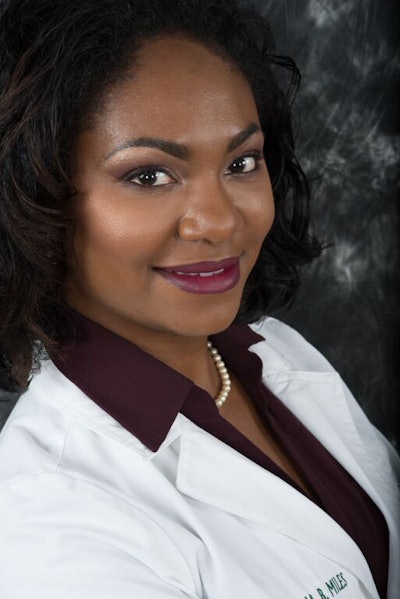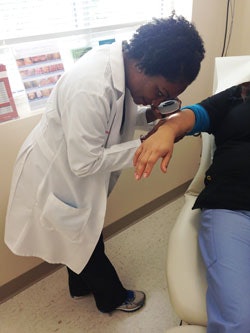Not all skin cancers are a result of over-exposure to the sun, and for darker-skinned people, particularly, skin cancer often shows up in different areas on the body than it does on White people.
 Dr. Katina Byrd Miles
Dr. Katina Byrd Miles“Among African Americans and native Africans, squamous cell carcinomas occur mainly on the legs, followed by the anogenital region (including both the anus and genitals),” according to the Skin Cancer Foundation.
Besides direct sun exposure, scars, radiation therapy or other trauma can lead to a diagnosis of skin cancer.
“We can’t say that it is caused by the sun; it could be due to trauma,” said Katina Byrd Miles, a dermatologist and owner of Skin Oasis, based in Gambrills, Md. “We had a patient who stepped on something like a sharp object. Another patient had an ulcer [on his foot] and he got a melanoma. But it’s difficult to know. The scalp, anus— it can be in areas where there is not a lot of sun exposure.”
The American Cancer society reported that melanoma, considered the most deadly form of skin cancer, is more serious for black Americans when it appears on the sole of the foot or palm of the hand, or if it is in a nail bed, rather than from direct sun exposure.
According to the Centers for Disease Control (CDC), among men, White men were more likely to die of melanoma of the skin than any other group, followed by American Indian/Alaska Native, Hispanic, Black, and Asian/Pacific Islander men. Among women, White women were more likely to die of melanoma of the skin than any other group, followed by Hispanic, Black, and Asian/Pacific Islander women.
However, researchers also say that when people of color do contract cancer, it tends to be diagnosed at later stages, sometimes because it is not considered the immediate source when lesions or discoloration are found, because darker-skinned people are more tolerant of sun.

Researchers also said that clinicians should focus on preventive measures, including regular skin exams, self-examination, public education, and screening programs. Even with that, skin protection is important, Miles said.
“Black folks do believe they can’t burn” or get skin cancer, Miles said. “People of color are in denial. There is not a suspicion for it (skin cancer), and when they do find it, it is in the later stages.”
Miles said skin cancer appears more often on the hands and feet than other areas of the body, but it is not clear why that happens.
Some dermatologists have suggested that people are less likely to think about putting sunscreen on their hands and feet, especially the bottoms of their feet because they wear shoes, but the reflection of the sun on concrete, especially in the summer, could expose feet to greater risk.
“Anything is possible,” Miles said, “because we don’t know. You still want people to protect their skin, because the sun is stronger than it used to be, because the ozone layer is not as thick as it used to be.”
Miles recommends using a sunscreen with a baseline protection of 30.
“The trick is to reapply it every two hours,” she said. “The ingredients in sunscreen break down after two hours. During the winter, an SPF 15 is fine, but if you’re outside all day you want a 30.”
Steven Q. Wang, director of dermatologic surgery and dermatology at Memorial Sloan-Kettering Cancer Center at Basking Ridge, N.J., contends that some patients get a false sense of security when they use higher SPF sunscreens.
.
“Products with very high SPFs may also encourage individuals to neglect other photo-protective behaviors, like seeking the shade and wearing sun-protective clothing,” Wang wrote for The Skin Cancer Foundation. “By preventing sunburn, sunscreens with very high SPFs can create a false sense of security, prompting consumers to stay out in the sun longer. Sun damage (for example, UVA damage) can take place without skin-reddening doses of UV radiation, and even the best sunscreens should be considered just one vital part of a comprehensive sun protection regimen.”
Miles said a cold compress and aloe vera gel should be applied immediately after a serious sunburn, followed by a visit to a dermatologist as soon as possible. She also recommended the use of creams and aloe vera to keep the area moisturized.
Blistering needs immediate medical attention because it increases the risk of skin cancer.
Miles also recommends an annual skin check during which the dermatologist examines the patient from head to toe to look for abnormal pigmentation, which may signal a problem.
Jackie Jones is a journalism educator and writer based in Washington, D.C.














